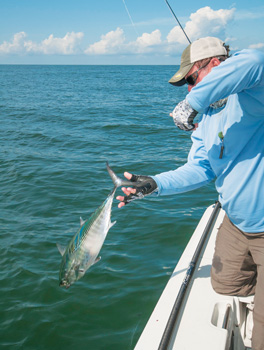Catch and release

rusty chinnis | sun
Captain Rick Grassett launches a little tunny after a
quick picture to give it a head start.
Catch and release is practiced by all anglers. Even those that take their catch home or to market release undersized fish. Many anglers are driven by the desire to protect sport fish populations, realizing that they are vulnerable and not the endless resource that they were once thought to be. Other anglers enjoy keeping a fish to eat but release most of their catch. Once a novel idea, Catch and Release, has become common place among a cadre of anglers.
Anglers, unlike hunters can pursue their passion and release their prey. Many hunters and anglers are advocates for their sport and invest time and money in protecting the habitat and health of the fish and animals they pursue.
Most anglers I know who practice catch and release have no problem with taking an occasional fish home for dinner. It's more about enjoying the sport and trying to be proactive in helping it to remain healthy and viable. There are certain species, like tarpon, that anglers seldom if ever kill. Catch and release is not just about releasing fish that you don't want, it's also about releasing undersized fish or species that aren't valued at the table. Catch and release in any form is a wise use of the resource, but anglers must know how to properly handle the fish they let go.
When we get cut, bruised or battered we can head for the local drug store or the Emergency Room. Not so for fish. For them it's heal or die and in their world it's the sick and wounded that fall prey to predators. What a shame to do the right thing, releasing a big speckled trout full of row, only to have it eaten by a shark, barracuda or other predator because it wasn't handled properly. Releasing fish with a minimum of damage applies to a 6 pound trout, a 150 pound tarpon and everything in between.
First, make sure you match tackle to the task. Trying to land a big tarpon on twenty pound tackle might be okay if you're experienced, but to the inexperienced it's like announcing a free meal to sharks that ply local waters looking for weak or injured prey. Enjoy the action but land the fish as quickly as possible. Once you have the fish under control, it's best to leave them in the water. If you've been fighting them for a long time revive them alongside the boat. If you can reach the water over the gunwale, slowly move the boat forward while holding the fish. This forces water and oxygen through their gills. They'll let you know when they're ready to swim away. Launch fast swimming fish like little tunny and king mackerel head first to give them a head start.
A de-hooker is a great addition to any boat. When you use one you seldom have to touch the fish. They will keep your hands clean and prevent you from inadvertently harming the fish. Fish secrete a protective coating that covers the scales and skin. This mucus membrane acts as a defense against invasion by bacterial, parasitic, and fungal pathogens. De-hookers come in various shapes depending on how they're used. The simplest is J shaped and removes hooks in or near the jaw. A circular shaped longer version allows anglers to remove hooks that are deep in the throat of a fish.
Anglers who fish for reef fish like snapper and grouper need to learn how to "vent" fish with inflated swim bladders. Bringing the fish up from deep depths fast bloats the bladder, which has to be punctured to allow the fish to reach the bottom. A good presentation of the process is available at http://catchandrelease.org/Fish%20Venting%20Flash10/player.html.
Anglers that release fish may want to take a picture to document their catch. This is best accomplished when you're prepared in advance. Set your exposure and have an idea where in the boat you want to take the picture. If you remove the fish from the water, hold it horizontally with one hand near the head and the other under the fish's belly to help support its weight. Holding a fish vertically puts a strain on the internal organs and can potentially dislocate its jaw.
By being prepared we can get the fish back in the water fast thus insuring its chances of survival. Taking the time and having the tools and knowledge to release fish mindfully is a great way to help insure we have a healthy population of fish now and into the future.

